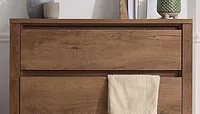New Additive to Enhance Surface Cleanability


A new hydroxy- (OH) functional silicone modified acrylate additive can enhance the surface-cleaning properties (cleanability) of coatings. Crosslinkable by way of OH-groups, BYK-Silclean[R] 3700 provides long-lasting significant improvements in cleanability so that adhering dust and dirt particles as well as graffiti can be removed much easier compared to "normal" surfaces.

Lotus-Effect
The phenomenon of the water repellency of plant leaf surfaces has been known for many years. The correlation of water repellency and self-cleaning properties of such surfaces has only recently been investigated in detail1: the adhesion of contaminating particles ("dirt") is greatly reduced, and water droplets rolling across the surface can easily pick up the contaminating particles to leave behind a cleaned surface (see Figures 1-2).
The Lotus-Effect itself is based on surface roughness caused by microstructures (see Figure 3) in combination with a highly hydrophobic surface. The combination of both properties reduces the contact area between solid particulates or droplets of liquid on the leaf's surface drastically; liquids such as water, exhibit very high contact angles (see Figure 4).

Once the principles of this effect were understood, it was possible to replicate it artificially on surfaces such as facades, roofs and coatings. The biological system was used as a model to improve the properties of these man-made surfaces. For demonstration purposes, Figure 6 shows a plastic spoon that is partially coated with a micro-structured, hydrophobic coating; the self-cleaning properties are clearly visible.
A consequence of the necessary micro-structure is that high-gloss surfaces are not possible. Surface structure always leads increased diffusion and reduced reflection of light, resulting in a flatted or low-gloss appearance.

Lotus-Effect in Coatings
To transfer the Lotus-Effect into coatings, it is necessary to create a hydrophobic surface with very low surface tension, along with the appropriate micro-structure. Additives can contribute to the Lotus-Effect by increasing hydrophobicity and reducing surface tensions. Such additives will not create the necessary micro-structure; the structure must be introduced by other means (e.g., high amount of suitable extender pigments, etching, stamping). This article introduces a new surface additive that can be used for Lotus-Effect coatings. In the absence of a micro-structure, the true Lotus-Effect is not created but something that comes very close is: the resulting surface does not have self-cleaning properties but it is much easier to clean than conventional surfaces. The absence of the surface micro-structure allows high-gloss and transparent coatings to be formulated.


Introduction of a New Additive
An easily cleaned surface is an important target of new developments not only in architectural coatings but also general industrial coatings (e.g., coatings for household appliances), wood coatings (e.g., kitchen cabinets), plastic coatings (coatings for consumer electronics) and marine paints. Fluorinated resins are well known not only for superior durability but also for their excellent dirt-releasing properties. A specialty application coating in the architectural market uses a very hydrophylic surface that is easily cleaned by rain. This easy surface-cleaning property, or cleanability, is typically a function of the specific binders selected to form the film. However, good cleanability can also be obtained with "conventional" binders when they are modified with certain additives. Among those additives, crosslinkable silicone containing polymers provide a unique set of properties.


Test Results
Numerous evaluations were made in two-pack polyurethanes with acrylic and polyester polyols, baking polyester-melamine, and acrylic-melamine systems. Films containing the new silicone-modified acrylate additive exhibit a hydrophobic and oleophobic surface with several other interesting properties.
Surface Energy/Surface Tension of the Dry Film
A physical parameter used to characterize the surface's cleanability is the surface energy or surface tension of the cured coating, consisting of a "polar" and a "disperse" component. Surface energy reduction capabilities of the new silicone-modified crosslinkable acrylate additive were evaluated in a two-pack PU coating. According to these test results, the overall surface tension of the dry film is only reduced approximately 15% by the silicone-modified acrylate additive. However, the polar component of the surface tension is reduced by more than 97%. This reduced polar component of the surface tension remains unchanged even after surface washing with 80 deg C hot water -- an excellent indication of its permanence (see Figures 7-8).
Surface Tension of Liquid Coatings
The surface tension reduction capabilities of the new additive in liquid coatings are very similar to those of polyether-modified dimethyl polysiloxanes. Table 2 shows the (static equilibrium) surface tension reduction by the new additive in comparison to a conventional polyether-modified silicone typically used as a slip, substrate wetting and anti-cratering additive. Due to the similarity of the surface tension values, the new additive can provide not only easily cleaned surfaces, but is also suitable for improving substrate wetting and anti-cratering properties of liquid coatings.
Dirt/Dust-Release Properties
The dirt-releasing properties of a coating's surface can be evaluated by rating the degree of removal of solid particulates on the coating's surface. A common and crucial test is to contaminate the coating surface with red iron oxide or carbon black pigment and then evaluate the surface's ability to be cleaned by a gentle rinse with detergent-free tap water.Table 3 shows the dirt-releasing properties of various baking and air-drying OH-crosslinkable systems. According to the results, the incorporation of the new silicone-modified polyacrylate provides complete and easy removal of contaminating particles on the surface in all three systems.

Anti-Fouling Properties
Low-energy surfaces may provide a certain level of resistance to fouling by marine organisms such as barnacles, slime, seaweed, etc. In order to investigate possible anti-fouling properties, a two-pack acrylic-polyurethane coating without anti-fouling agents was formulated with 2, 4 and 6% silicone-acrylic additive, applied onto suitable substrates, cured and subjected to static seawater fouling tests in Singapore, 60 cm below the surface for two months.Results show that the silicone-modified acrylate additive cannot completely prevent fouling, but significant changes in the composition of fouling organisms indicate that this approach can be a basis for future developments.
The amount of barnacles, slime and seaweed growth on the coating surface was lowest at approximately 4% additive (see Figure 11). However, contamination by fungus appears to peak at 4% additive. The increased fungal growth is not a concern because it is easily removed. Although the total amount of foulant (slime, mussels, barnacles, seaweed, fungus, worms) was only reduced by 13%, the compositional change of the fouling organisms and ease of removal of those organisms is highly indicative of the potential benefits of this approach. Keep in mind that this was a static test; in actual use conditions, there would be a steady flow of sea water to help keep the surface clean.
Anti-Graffiti Properties
Resistance to graffiti can be tested using various types of permanent marker pens and evaluating their ease of removal by wiping with a dry clean cloth. Another common technique is to test the removal of spray paint (aerosol), the most widely used medium for graffiti, from surfaces with high-pressure water or steam. The silicone-acrylate additive provides in both tests very impressive improvements in the anti-graffiti properties of coatings, even with the most persistent graffiti.However, excellent resistance to graffiti severely limits recoat adhesion. This additive is only recommended for those applications not needing recoatability. Recoating is only possible after thorough surface sanding, or following prolonged exterior exposure and subsequent erosion of the upper surface of the coating.
Practical Experiences and Applications
Due to the described properties of the new additive, many interesting coatings with unique surface properties can be developed for new applications. Potential areas for this new technology are in the following.- Polyurethane coatings for buildings, facades, ceramic tiles of tunnels that are graffiti resistant (for easy removal of graffiti).
- Polyurethane wood coatings for kitchen cabinets (for easy cleaning).
- Baking alkyd-melamine and polyester-melamine coatings for household appliances (for easy cleaning and scratch resistance).
- Polyurethane coatings with improved foulant releasing properties due to the low surface energy (anti-fouling for higher speed vessels).
- Polyurethane coatings for consumer electronics with easily cleaned and scratch-resistant surfaces.
- Interior coatings for metal drums / pails / other technical metal packaging containers to provide more complete drainage of the contents.
Summary
A new silicone-modified crosslinkable acrylate additive has been developed that provides surfaces with easy cleaning characteristics along with many other interesting properties in OH-crosslinkable systems. Best results are obtained with 4-6% additive on liquid coating weight (1-1.5% active substance on total).Acknowledgement
The authors would like to thank Kansai Paint in Singapore for its valuable support in performing and evaluating the anti-fouling test results.Figures 1-4 are used in this paper with the kind permission of Prof. W. Barthlott and Dr. C. Neinhuis (University of the City of Bonn, Germany).
This article is based on a paper presented at the 30th Annual International Waterborne, High-Solids, & Powder Coatings Symposium[R] in New Orleans.
For more information on additives, contact John W. Du, BYK-Chemie USA, 524 South Cherry St., Wallingfor, CT 06492; e-mail jdu@bykchemieusa.com.
References
1 Barthlott, W. & Neinhuis, C., 1997: The Purity of Sacred Lotus or Escape From Contamination in Biological Surfaces, Planta 202, 1-8.2 Neinhuis, C. & Barthlott, W., 1997: Characterisation and Distribution of Water-Repellent, Self-Cleaning Plant Surfaces. Annals of Botany 79, 667-677.
Links
Looking for a reprint of this article?
From high-res PDFs to custom plaques, order your copy today!








